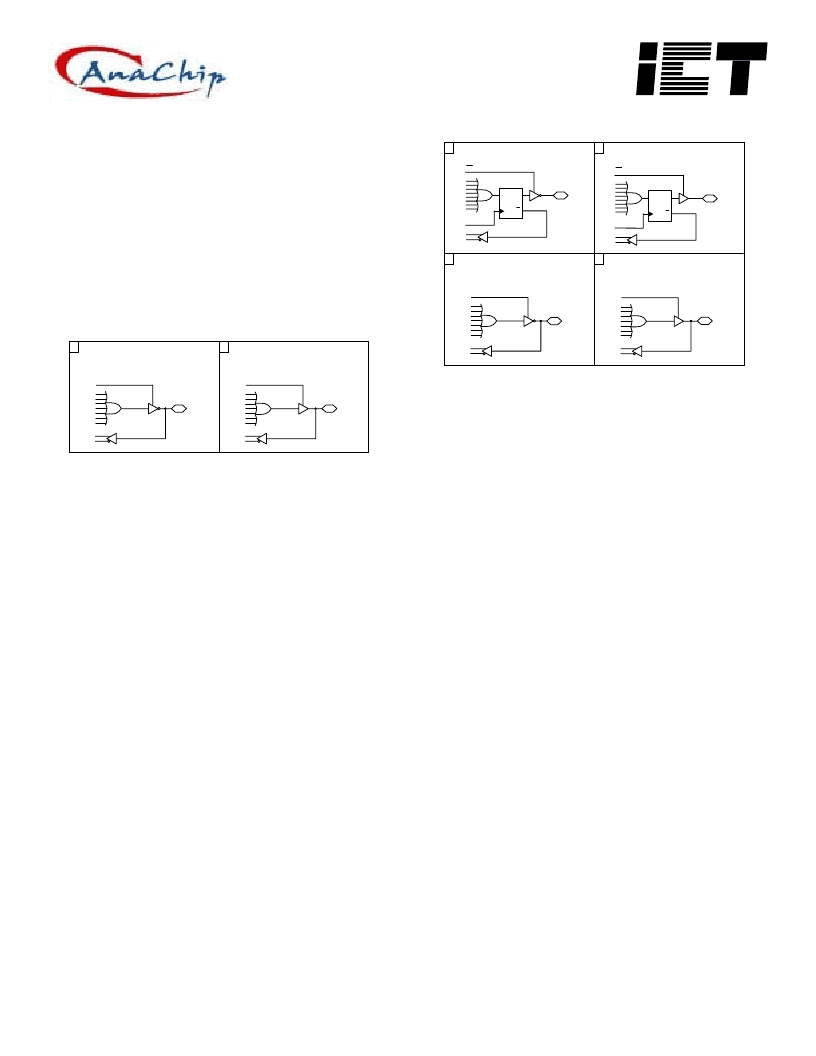- 您現(xiàn)在的位置:買賣IC網(wǎng) > PDF目錄369991 > PEEL16CV8J-25 CMOS Programmable Electrically Erasable Logic Device PDF資料下載
參數(shù)資料
| 型號(hào): | PEEL16CV8J-25 |
| 英文描述: | CMOS Programmable Electrically Erasable Logic Device |
| 中文描述: | 的CMOS電可擦除可編程邏輯器件 |
| 文件頁(yè)數(shù): | 4/11頁(yè) |
| 文件大小: | 386K |
| 代理商: | PEEL16CV8J-25 |

Anachip Corp.
www.anachip.com.tw Rev. 1.0 Dec 16, 2004
4/11
Complex Mode
In Complex mode, seven product terms
feed the OR array which can
generate
a purely combinatorial function for the output pin. The pro-
grammable output polarity selector provides active-high or active-low
logic, eliminating the need for
external inverters. The
output buffer is
controlled by the eighth product term, allowing the macrocell to be con-
figured for input, output, or bidirectional functions. Feedback into the
array for input or bidirectional functions is available on all pins except 12
and 19.
Figure
4 shows the possible complex mode
macrocell configura-
tions.
1
Registered Mode
Active Low Registered Output
OE PIN
D
Q
Q
CLK PIN
3
Registered Mode
PRODUCT TERM
2
Registered Mode
Active High Registered Output
OE PIN
D
Q
Q
CLK PIN
4
Registered Mode
Active High Combinatorial Output
PRODUCT TERM
1
Active Low Output
PRODUCT TERM
2
Complex Mode
Active High Output
PRODUCT TERM
Figure 5
- Macrocell
Configurations for the Registered Mode of the
PEEL
TM
16CV8
(see
Figure 8 for logic Array)
Design Security
The PEEL
TM
16CV8 provides
a special
EEPROM security bit that
pre-
vents unauthorized reading or copying of designs programmed into the
device.
The security bit is set by the PLD programmer,
either
at the con-
clusion of the programming cycle or
as
a separate step, after the device
has been programmed. Once the security bit has been set it is impossi-
ble to verify (read) or program the PEEL
TM
until the entire device has first
been erased with the bulk-erase function.
Signature Word
The
signature word feature allows a 64-bit code to
be programmed into
the PEEL
TM
16CV8. The code
cannot be read back after
the security bit
has been
set. The signature
word can
be used
to identify
the pattern
programmed into the device or to record the design revision, etc.
Figure 4 - Macrocell Configurations for the Complex Mode of the
PEEL
TM
16CV8
(see
Figure 7 for Logic Array)
Registered Mode
Registered mode provides eight product terms to the OR array for regis-
tered
functions.
The
programmable
output
polarity
selector
provides
active-high or active-low logic, eliminating the need for external invert-
ers.
(Note, however,
that if register
is selected, the
PEEL
TM
16CV8
reg-
gisters power-up reset and
so before the first clock arrives the output at
the pin
will
be low if
the
user has
selected active-high logic
and high
if the
user has selected active-low logic. If combinatorial is selected, the output
will be a
function of the
logic.) For registered functions,
the output buffer
enable is controlled directly from the /OE control pin. Feedback into the
array comes from the macrocell register. In Registered mode, input
pins
1 and 11
are permanently allocated as CLK
and /OE, respec- tively.
Figure
8
shows the
logic array of the
PEEL
TM
16CV8 configured in Registered
mode.
Registered mode also provides the option
of configuring a macrocell for
combinatorial operation, with seven product
terms feeding the OR func-
tion.
Again the programmable output polarity selector provides active-high or
active-low logic.
The output
buffer enable
is
controlled by the eighth
product term,
allowing
the macrocell to be
configured for
input, output, or
bidirectional functions. Feedback into the
array for input or
bidirectional
functions is available on
all
I/O pins. Macrocell Configurations for the
Registered Mode of the PEEL
TM
16CV8
相關(guān)PDF資料 |
PDF描述 |
|---|---|
| PEEL16CV8J-25L | CMOS Programmable Electrically Erasable Logic Device |
| PEEL16CV8 | CMOS Programmable Electrically Erasable Logic Device |
| PEEL16CV8P-25 | CMOS Programmable Electrically Erasable Logic Device |
| PEEL16CV8P-25L | CMOS Programmable Electrically Erasable Logic Device |
| PEEL18CV8ZT-25 | CMOS Programmable Electrically Erasable Logic Device |
相關(guān)代理商/技術(shù)參數(shù) |
參數(shù)描述 |
|---|---|
| PEEL16CV8J-25L | 功能描述:SPLD - 簡(jiǎn)單可編程邏輯器件 10 Input 8 I/O 25ns RoHS:否 制造商:Texas Instruments 邏輯系列:TICPAL22V10Z 大電池?cái)?shù)量:10 最大工作頻率:66 MHz 延遲時(shí)間:25 ns 工作電源電壓:4.75 V to 5.25 V 電源電流:100 uA 最大工作溫度:+ 75 C 最小工作溫度:0 C 安裝風(fēng)格:Through Hole 封裝 / 箱體:DIP-24 |
| PEEL16CV8JI-25 | 功能描述:SPLD - 簡(jiǎn)單可編程邏輯器件 10 INP 8 I/O 25ns RoHS:否 制造商:Texas Instruments 邏輯系列:TICPAL22V10Z 大電池?cái)?shù)量:10 最大工作頻率:66 MHz 延遲時(shí)間:25 ns 工作電源電壓:4.75 V to 5.25 V 電源電流:100 uA 最大工作溫度:+ 75 C 最小工作溫度:0 C 安裝風(fēng)格:Through Hole 封裝 / 箱體:DIP-24 |
| PEEL16CV8JI-25L | 功能描述:SPLD - 簡(jiǎn)單可編程邏輯器件 10 Input 8 I/O 25ns RoHS:否 制造商:Texas Instruments 邏輯系列:TICPAL22V10Z 大電池?cái)?shù)量:10 最大工作頻率:66 MHz 延遲時(shí)間:25 ns 工作電源電壓:4.75 V to 5.25 V 電源電流:100 uA 最大工作溫度:+ 75 C 最小工作溫度:0 C 安裝風(fēng)格:Through Hole 封裝 / 箱體:DIP-24 |
| PEEL16CV8P15 | 制造商:未知廠家 制造商全稱:未知廠家 功能描述:Logic IC |
| PEEL16CV8P25 | 制造商:未知廠家 制造商全稱:未知廠家 功能描述:Logic IC |
發(fā)布緊急采購(gòu),3分鐘左右您將得到回復(fù)。